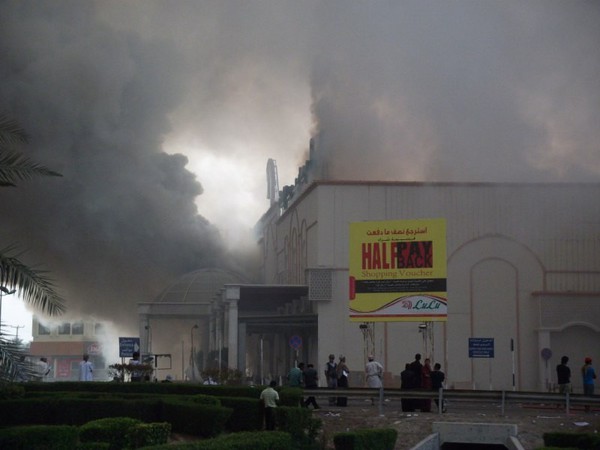Oman Feature: A Not-Quite-So-Quiet Arab State
 Thursday, November 10, 2011 at 13:47 |
Thursday, November 10, 2011 at 13:47 |  Scott Lucas in
Scott Lucas in  EA Middle East and Turkey,
EA Middle East and Turkey,  Middle East and Iran
Middle East and Iran  Supermarket on Fire During Oman Protests, February 2011Ra'id Zuhair Al-Jamali writes for Foreign Policy magazine:
Supermarket on Fire During Oman Protests, February 2011Ra'id Zuhair Al-Jamali writes for Foreign Policy magazine:
Oman held parliamentary elections on October 15 -- two weeks before the Tunisian elections that captured the world's attention. But nobody paid them much mind. And why should they? There is not much more to be said beyond the high "participation" rate (76 percent of those who bothered to register), the solitude that the one elected woman may feel among her 83 male colleagues, or the election of three protesters. Tribal alliances still drove results in a country where political parties are not allowed and where, for most seats, 1,500 votes is enough to get elected.
But this might be deceiving. This has been Oman's least quiet year in a generation. The Economist scored Oman sixth highest within its (unsophisticated) Arab instability index in early February, a forecast met with wide incredulity at the time. A few weeks later, the country was shaken with memorable scenes of unrest: protests -- some violent, most peaceful, loyalty marches, regime concessions, a GCC "Marshall Plan," labor strikes and opportunistic demands, and regime crackdowns. The ground has significantly shifted beneath the feet of a regime that has overseen the rapid transformation of society over the last 40 years, underwritten by absolute power and facilitated by oil income.
Muscat witnessed its first significant demonstration only three days after Ben Ali fled Tunisia. By the second "Green March" -- on that first Friday sans Mubarak - it was undeniable that a new wind was blowing. Vibrancy of Bahrain's early Lulu scenes and the intensifying youth-led protests in Yemen only sharpened the palpable mood for change. Secure in its own rhetoric of Omani exceptionalism, the government chose not to confront crowds numbering in the low hundreds rallying mainly against corruption.
One week later, though, massive protests struck in the rapidly industrializing city of Sohar, setting in motion a month of unprecedented countrywide unrest, government concessions, labor opportunism, and even promises of GCC economic support. By mid March, however, specters of a bloody crackdown in Bahrain and Yemen fed fears of deterioration. On March 29, the army finally moved to clear the protests in Sohar, restoring safe passage for the industrial port area. Over the next month, order was gradually enforced through security and legal channels, culminating in the May 12 breakup of the last major protest site in Salalah. Whatever residual will for public manifestation there remained, summer heat soon dissolved.
Yet roots of the Omani protests extend deeper than a simple imitation of the prevailing Arab mood.

Reader Comments